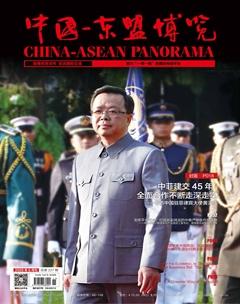ASEAN’s RCEP and Sustainability Challenges and Achievements
Kaewkamol Pitakdumrongkit

As the end of 2019 drew near, Thailand hosted two ASEAN summits under the theme “Advancing Partnership for Sustainability”. Looking at how the meetings unfolded, one may ask: what were ASEANs major economic achievements in 2019? And what key challenges remain for 2020?
Last year ASEAN made important economic gains in trade and sustainable development. The biggest trade accomplishment was the conclusion of negotiations for the Regional Comprehensive Economic Partnership (RCEP) in November by 15 nations — 10 ASEAN member states and 5 ASEAN dialogue partners (Australia, China, Japan, New Zealand and South Korea). According to the Joint Leaders Statement at the third RCEP Summit, the 15 members “concluded text-based negotiations for all 20 chapters and essentially all their market access issues; and tasked legal scrubbing by them to commence for signing in 2020”.
Although faced with some criticism, the conclusion of RCEP was a success
First, while critics assert that RCEP is not as ambitious as the Comprehensive and Progressive Agreement for Trans-Pacific Partnership (CPTPP), the former is a “l(fā)iving document” whose details and quality can improve over time. The deal will provide firms with greater market access, enhancing transnational production networks and thereby enabling consumers to enjoy a broader range of goods.
Second, Indias absence from the agreement should not be seen as a failure because the door has been left ajar to join in the future. Even without India, the agreement is set to be signed this year, making RCEP the worlds biggest trading bloc by both population and economic weight. Still, the pact will be smaller than envisaged — it will create a combined market of 2.2 billion people (down from 3.6 billion) and will account for 29% (down from 33%) of the worlds GDP.
Third, the conclusion of RCEP will restore market confidence to its 15 signatory countries, including the 10 ASEAN members. It showed the market that these economies will band together against the backdrop of rising uncertainties and escalating US-China tensions.
Fourth, RCEP enables ASEAN to inch closer to completing the ASEAN Economic Community 2025 (AEC 2025) — an economic integration project among 10 Southeast Asian countries. RCEP will help these states better integrate into the worlds economy and achieve a “Global ASEAN”. This is one of AEC 2025s objectives.
Sustainability challenges and achievements
ASEANs also made great strides in promoting sustainable development in 2019. Last year, ASEAN members agreed to launch the ASEAN Centre for Sustainable Development Studies and Dialogue (ACSDSD), aimed at facilitating collaboration on sustainable development between ASEAN and its development partners. ACSDSD can augment ASEAN leadership in promoting international collaboration on sustainable development by providing a platform for ASEAN to bring together various stakeholders to exchange their views on the issue. The Centre will help ASEAN to meet the United Nations Sustainable Development Goals by 2030.
Despite these accomplishments, ASEAN still has challenges to face in 2020. The first concerns Indias participation in RCEP. Indian involvement in RCEP would not only expand the combined regional market but also strengthen regional transnational services supply chains. In short, as services increasingly take up a greater share of the global economy, the bloc would grant Indian services firms access to larger markets. This will enable businesses in other RCEP countries to work with Indian firms to bolster their regions competitiveness in services trade.
Strong domestic opposition in India means this is easier said than done. Many fear that the agreement will lead to import surges, which they argue could exacerbate Indias US$ 105 billion trade deficit, undermine domestic farmers and industries and crush the “Make in India” initiative.
Second, RCEP will not render ASEAN states immune from the impacts of US-China rivalry. On January 15, Washington and Beijing inked the “phase one” agreement, in which the former would not impose or reduce tariffs on still swathes of Chinese products while the latter would selectively eliminate tariffs on some US products to meet purchase requirements of US goods. However, this arrangement does not address Chinese government subsidies given to state-owned enterprises and increased US restrictions on Chinese investment. As a result, 2020 may witness continued clashing between these states emerging from these issues. The two powers are also competing on many fronts, including over technology. The transformative effect that 5G will have on future productivity means this competition is likely to persist in the long-term.
Regarding sustainable development, significant challenges remain. ASEANs leadership on sustainable development will hinge on how effective the ACSDSD can be in facilitating cooperation between ASEAN and non-ASEAN entities. To achieve this, ASEAN can learn from its past involvement in coordinating committees such as the ASEAN Coordinating Committee on Connectivity and the ASEAN Coordinating Centre for Humanitarian Assistance on Disaster Management.
Given that sustainable development is multi-faceted and cross-sectoral, achieving such leadership will be a challenge. To ensure projects do not lead to debt unsustainability or environmental degradation, the Centre must work with the ASEAN+3 Macroeconomic Research Office (AMRO) and the ASEAN Working Group on Nature Conservation and Biodiversity respectively.
The jury is still out on the degree to which the ACSDSD can successfully pool resources from and facilitate cooperation among dissimilar stakeholders. But ASEANs success in handling difficult negotiations such as RCEP over the past year suggests that further big achievements can and should be pursued.
· Source: East Asian Forum

